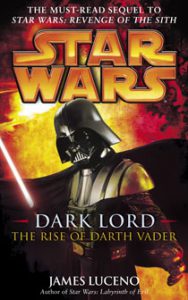We knew Anakin Skywalker and Darth Vader were the same person since 1980, but it wasn’t until after “Revenge of the Sith” came out that we learned how Anakin feels being Vader. For that reason, “Dark Lord: The Rise of Darth Vader” (2005) was one of the most anticipated Expanded Universe novels, and — along with his “Darth Plagueis” (2012) – it remains one of James Luceno’s best and most essential EU works.
Some authors had tiptoed into this territory, including Steve Perry, who in “Shadows of the Empire” (1996) wrote a passage where Vader heals his lungs with the dark side, only to lose his connection with the Force once he feels happiness. Luceno expands on this concept, as Vader’s hatred of the suit – and his suspicion that Sidious made the suit less than comfortable – partially drives his dark-side powers.
Passages like this one on page 55 of the paperback — “Without revealing his distress at being unable to maintain the kneeling posture …” – illustrate Vader’s constant physical discomfort. We can understand – if not sympathize with – his decision to stick with the dark side. At other points, the author illustrates Vader’s more commonly known reason for his choice of allegiance: He aims to eventually overthrow Palpatine, in the grand Sith tradition.
Sidious, for his part, is using Vader simply as a valuable military tool against insurgents and a psychological warfare weapon against the citizenry. (In one tense sequence, Vader pays a visit to Senator Bail and Queen Breha Organa on Alderaan — with infant Leia nearby, naturally — as part of his fear campaign.) Palpatine has no intention of letting Vader overthrow him. He aims to live forever, a nice reference to the “Dark Empire” comics (1991). “By the time Vader was capable of becoming a risk to his Mastery,” Sidious reflects on page 320, “Sidious would be fully conversant with the secrets Plagueis had spent a lifetime seeking – the power of life over death.”
One area where “Dark Lord” draws some criticism is that Vader is not the main character; indeed, he doesn’t appear until page 53. As with “Darth Maul: Shadow Hunter” (2001), the main character is not the titular villain, but rather a heroic Jedi, in this case, Master Roan Shryne. Padawan Olee Starstone is also the point-of-view character at times. Some Jedi survive this book, but they aren’t heard from again, so it makes a reader wonder why so much time was spent on them.
On the other hand, we do see how people view the rise of this new Sith lord who seemingly came out of nowhere, and how they have to adjust to him. Upon seeing Vader in action, some of the Jedi throw away their lightsabers and other Jedi trappings – as did the Jedi at the end of the “Republic” comics. They immediately realize they have no chance in a fight, and that a patient, long-term strategy is best. The Imperials also have to adjust; one wrongly addresses him as “Admiral Vader” before the term “Lord” had permeated the ranks. As for the switch from “clone trooper” to “stormtrooper,” there’s no definitive turning point; Luceno just starts using “stormtrooper” in this novel, even though he notes that Palpatine is still using clones to fill the ranks.

“Dark Lord” includes some EU artifacts that were later overwritten by “The Clone Wars” TV series. In Season 6, we learn that the clones are fitted with chips that trigger them to kill Jedi when they hear the phrase “Order 66.” But that was not the case in EU works such as the “Republic Commando” novels and this book. Indeed, Vader reflects on how Palpatine had been counting on the clones’ loyalty to carry out the order, on page 56:
(Vader) knew that Order 66 had not been hardwired into the clones by the Kaminoans who had grown them. Rather, the troopers – the commanders, especially – had been programmed to demonstrate unfailing loyalty to the Supreme Chancellor, in his role as Commander in Chief of the Grand Army of the Republic.
Another EU artifact is that Vader’s and Grand Moff Tarkin’s relationship is new here. Vader notes that he had met Tarkin one other time – in the famous final image from “Revenge of the Sith.” “The Clone Wars” later revealed that Anakin and Tarkin worked together, and developed an affinity for each other’s political views, in Season 3’s “Citadel” arc. And in the EU itself, a young Anakin meets Tarkin in “Rogue Planet” (2000); this might be a rare case of Luceno dropping the ball on EU continuity, or he perhaps decided that that neither person made the connection back to that first encounter.
The fact that Tarkin doesn’t know Vader is Anakin in “Dark Lord” still holds up, at least. Later in the EU timeline, in “Death Star” (2007), Tarkin is putting the pieces together on his own, but it’s clear that Sidious and Palpatine never explicitly tell him. (In the Disney timeline, Luceno’s “Tarkin” similarly shows that Tarkin suspects the link, but hasn’t been told.)
One of “Dark Lord’s” coolest tie-ins, and one I had forgotten about since my first read, is the role of Chewbacca. As we see the Empire round up Wookiee slaves for use on the Death Star’s construction (or so it’s strongly implied), Chewbacca realizes he can’t hope to get to his village in time to save his family, so he flees with a band of Jedi and smugglers, resolving that there will be another time to fight.
Unfortunately, this leads to a convoluted branch of the EU narrative. It’s not until later in the timeline that Chewie marries Malla. So the family Chewie refers to in “Dark Lord” is not his wife or kid, it’s his parents and perhaps siblings. Wookieepedia reveals that two such family members are known by name – father Attichitcuk (Itchy) and sister Kallabow. Along with Chewie’s mother (remarkably, never mentioned in any story), these are probably the family he is referring to. Oddly, it seems from later stories that Chewie’s family never was captured by the Empire; the “Clone Wars Adventures” comic Volume 4 reveals that Itchy flees to the Shadowlands during the siege in “Dark Lord.” Ironically, we know that Chewie himself is later captured by Imperials and rescued by Han Solo; as chronicled in the “Chewbacca” comic (2000).
As a side note, the passages about the Empire destroying Kashyyyk and killing and capturing Wookiees nicely illustrates Palpatine’s speciesism. (Obviously, he sees everyone as being beneath him, but particularly non-humans.) While Luceno doesn’t explicitly address the Emperor’s prejudices – and oddly, we never did get an EU story where he demotes Sly Moore and Mas Amedda while humans such as Tarkin and Sate Pestage climb the ranks – the fact that Palpatine sees Wookiees as animals is palpable.
Luceno more smoothly addresses the issue of Obi-Wan Kenobi’s knowledge of Vader’s fate. At the end of “Revenge of the Sith,” Obi-Wan thinks Vader is dead; at the start of the classic trilogy, he knows Vader is alive. In the final pages of “Dark Lord,” Kenobi sees a mention of Darth Vader on the HoloNet news while he’s having a drink of water at an Anchorhead cantina. He asks himself whether Luke is now in even greater danger, but the ghost of Qui-Gon assures him that “Vader will never set foot on Tatooine, if only out of fear of reawakening Anakin” (p. 338).
While some people think Obi-Wan hiding Luke on Anakin’s home planet is ridiculous, Qui-Gon’s reasoning smooths things out, while also being a tidy lead-in to “Kenobi,” which takes place more or less concurrently with “Dark Lord.” And indeed, Vader never does return to the surface of Tatooine in the rest of the EU. (He does return there in the Disney canon, in the “Darth Vader” comics.)
While “Dark Lord” – like a fair number of EU works – includes some unresolved character arcs and threads, it is a nice capper to the story of Anakin’s transition to Vader (this is sometimes considered the final part of the “Dark Lord Trilogy,” following “Labyrinth of Evil” and “Revenge of the Sith”). It’s a solid “Star Wars” adventure and an essential installment in EU lore.

